This was published 8 years ago
Aboriginal tourism, Australia: Indigenous tourism's bright new future
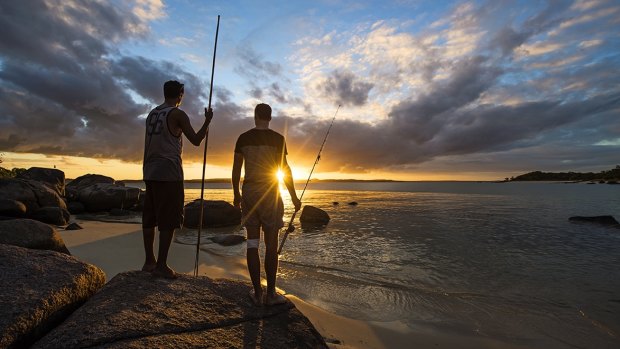
Bawaka in East Arnhem Land.Credit: Shanna McNaught
For their 13th birthdays, the grandchildren of Joy and Thomas Berlin receive an extraordinary gift to mark their entry to teenagehood. The grandparents, from Florida in the US, take the newly minted teen anywhere in the world he or she wants to go (although Joy has drawn the line at looking for narwhals at the ends of the earth).
But this is how and why Cassandra Berlin, of Ohio, found herself stalking mud crabs with a bamboo spear in Far North Queensland last month, just days after her milestone birthday. Cassandra wanted to learn about Australia's indigenous culture so the Berlins flew in to Sydney, on to Cairns and went out for the day with Juan Walker – a Kuku Yalanji man from Cooya Beach, north of Port Douglas.
After picking us up from Palm Cove – I'm tagging along on the Berlins' day tour – we trace the Captain Cook Highway north, past osprey nests crowning power poles and sulphur-crested cockatoos thieving the sugarcane.
At a remote beach we twist our feet into wet sand to unearth pippies – the first ingredient for our lunch – and learn which beachside plants make good bush medicine. Cassandra rubs morning glory leaves on to a patch of poison-ivy itch she's carried from home and says it helps. But it's at Cooya that we slide into a parallel world - one forged from mangroves and myths. To the north is Snapper Island, which on the map looks like a crocodile lying in wait. For Juan's mob, it's a dog that lost its tail, thanks to an axe-wielding woman.
Around here, the croc is boss – no one eats it out of respect. Juan tells us not to worry about salties and strangely, given the Palm Cove beachfront carries croc warnings, we don't. Instead, we cruise through the shallows towards a lone mangrove surrounded by seawater, scanning for crabs lying across the rippled tidal flats. Juan hurls his spear and hoists a muddy into the air. A small female crab scuttles over my feet. Juan's uncle, Percy Walker, bags more crabs.
We poke around in the mangroves, touching an anemone huddled into the roots. After scrubbing our hands with silver wattle – also known as soap bush - we head to Juan's mum's verandah. As we gorge ourselves on pawpaw, passionfruit and damper topped with golden syrup and just-grated coconut, Juan steams our seafood haul in chilli, garlic, butter and coconut oil, presenting the fragrant pile in a bowl. Instead of fancy forks, he uses a crab leg's tip to lever out the flesh. This verandah lunch is hardly glamorous but it's the best seafood meal of my life.
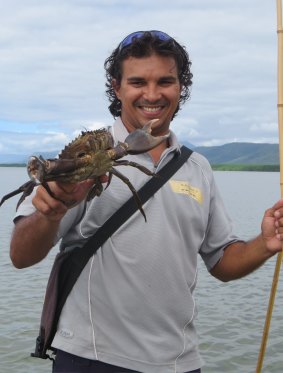
Juan Walker, a Kuku Yalanji man from Walkabout Cultural Adventures, catches a meal.Credit: Katrina Lobley
Juan's business, Walkabout Cultural Adventures, is one of Tourism Australia and Indigenous Business Australia's 52 Indigenous tourism champions. The program, run in conjunction with state and territory tourism organisations, helps established businesses with mentoring, marketing and business development. Tourism Australia has further boosted the sector by launching a short film showcasing the diversity of Australia's Indigenous tourism experiences (See the film for yourself in the video above)
Locations stretch from Cape Leveque in the Kimberley to Mt Borradaile in Arnhem Land and Sydney's Royal Botanic Gardens. Tourism Australia and Austrade have both invested $250,000 in the project. Internationally, the film will be seen in the US, the United Kingdom, Germany, China and South-East Asia. Domestically, it will screen at gateway points such as airports, airlines and hotels.
Made by indigenous director-cinematograher Warwick Thornton and director Brendan Fletcher, with a soundtrack from musician and composer Alex Lloyd of Amazing fame, the film's message is that Indigenous experiences aren't confined to the outback - they can be found just as easily in a big-city botanic garden or the middle of a rainforest.
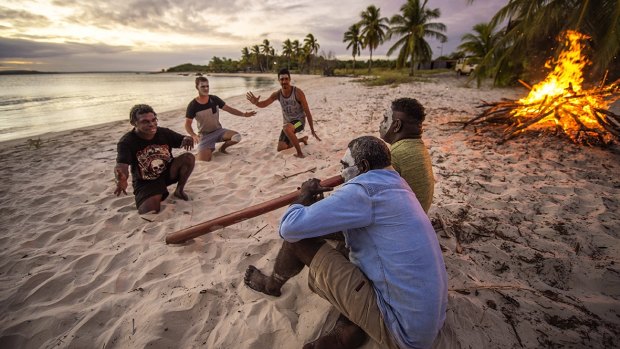
At Bawaka.Credit: Shanna McNaught
Far North Queensland's rainforest people have been telling visitors their stories for decades. Tjapukai Aboriginal Cultural Park began as an indigenous dance troupe performing in the basement of a Kuranda shopping centre in 1987. Two years later it moved to a purpose-built space down the street and in 1996 relocated north of Cairns with Tjapukai, owned by Indigenous Business Australia, unveiling a $13 million makeover in May.
Visitors now enter an interpretive centre that includes a dramatic contemporary gallery, theatres and restaurants, and reimagined shows, including an interactive evening fire-making performance that finishes with a fireball shooting 40 metres into the air. By day, visitors learn the finer points of throwing a boomerang or spear (handy if you're mud-crabbing later), watch dancers imitating brolgas, kangaroos and wallabies, or try their hand at islander weaving.
Tjapukai's chief executive officer, Greg Erwin, knows the region's Indigenous tourism scene well. He came to Tjapukai this year after four years as general manager of the $20 million Mossman Gorge Centre near Port Douglas. The centre, which opened in 2012, offers Dreamtime walks through the World Heritage-listed Daintree rainforest. At Tjapukai, visitors can chat with staff (72 percent of whom are Indigenous).
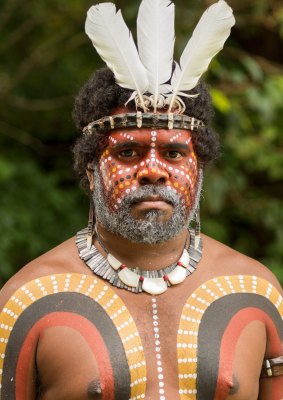
Tjapukai performer Dennis Hunter.Credit: Adam Bruzzone
"Having a positive engagement with an Indigenous Australian is something that a lot of people don't have the opportunity to do in their everyday life," says Erwin. "We find that people highly value that experience. They will appreciate the knowledge that's being passed on to them … but what really touches them is when they meet Aboriginal or Torres Strait Island people and develop a connection or bond."
One of Tjapukai's most charismatic and outgoing performers is Richard Bing, who dances, plays didgeridoo and leads activities such as the bush foods and medicine tour. He demonstrates how a snail shell can grate black bean and yellow walnuts before handing over a chunk of ants' nest. "If you eat too many cocky apples and get clogged up in the guts, crush that and make a drink out of it to loosen everything up," he advises.
Tjapukai sits next to Cairns' popular Skyrail attraction (Tjapukai, Skyrail and the Scenic Railway can be bundled into a full Cairns-Kuranda day trip). I ride one of Skyrail's glass-floored Diamond View gondolas with Tjapukai's Michell Kapteyn. At Barron Falls station, we disembark for an Indigenous ranger tour with Zane Saunders. He grew up in Kuranda but ancestrally his mob is from Fraser Island. "I tell people I'm Djabugay at heart," he says.
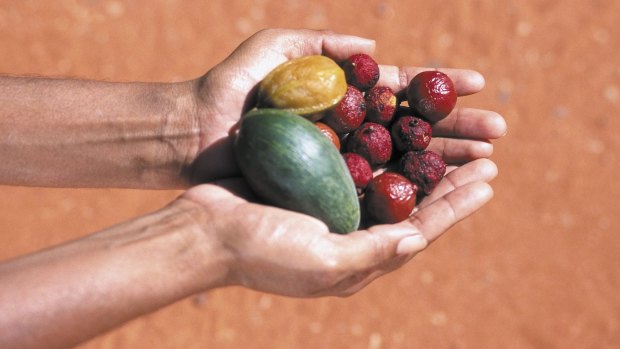
Bush tucker.Credit: Tourism NT
As he leads us through the rainforest to a secluded waterhole, he speaks English sprinkled liberally with Djabugay – an Indigenous language revived in these parts largely thanks to the work of local linguist and anthropologist Michael Quinn (his Djabugay-English dictionaries are for sale at the Kuranda Visitor Information Centre).
Saunders and Kapteyn swap stories about the spirits that inhabit the rainforest: the water fairies and the "tall man". Kapteyn is fascinated that Saunders has experienced the little hairy people. "Two young lads and I were catching fish and these noises came from the forest," Saunders recalls as we sit, absorbing the place. "All of a sudden, small pebbles came out and landed in front of me. That was the little people saying, 'You've caught enough fish – leave some for us'."
Like most Indigenous stories – whether it's how the thorny devil acquired its spikes or how the lizard got its frill - this one conveys important lessons (take only what you need, greed is bad). Kapteyn says: "These stories are not only to bring fear into us or discipline but to pass on tradition."
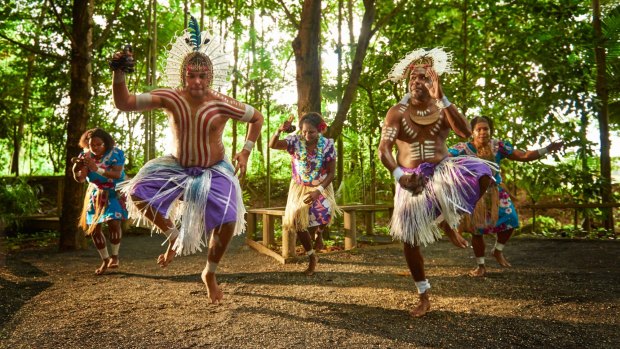
Indigenous dancers.Credit: Adam Bruzzone
For Juan Walker, his business is about much more than passing on knowledge. "It allows me to stay on country," he says. He was about to take up an electrician's apprenticeship in a mine when his grandmother spotted another option for him – guiding guests at Daintree Eco Lodge & Spa. The property includes a secluded waterfall that is a sacred women's place. "It took me a while to be able to talk to strangers," he says. "That was the hardest part – I was shy."
As Walker drops me at the lodge, the insistent call of green-eyed tree frogs fills the air. That usually means rain is coming (the frogs are right, there's a downpour three hours later). Cassandra and Joy are returning to Palm Cove for Indigenous-themed spa treatments; I'm heading into the resort for a lemon myrtle mojito. We part ways knowing we've shared one profound – and deeply delicious - day.
The writer was a guest of Tjapukai Aboriginal Cultural Park, Skyrail Rainforest Cableway, Kuranda Scenic Railway, Walkabout Cultural Adventures, Daintree Eco Lodge& Spa.
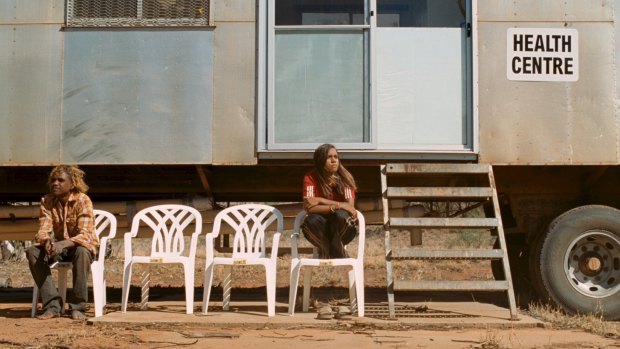
A scene from Samson & Delilah, by Warwick Thornton.
See tourism.australia.com; walkaboutadventures.com.au, tjapukai.com.au, mossmangorge.com.au, daintree-ecolodge.com.au.
Q&A with Warwick Thornton
Indigenous director-cinematographer Warwick Thornton, of Alice Springs, has directed films such as Samson and Delilah and worked as a cinematographer on The Sapphires. Joining forces with Brendan Fletcher, who directed the feature film Mad Bastards against a Kimberley backdrop, the pair spent three weeks doing Indigenous tours before returning to film the most stunning moments. Editing took another 12 weeks.
What was the process like?
You have to spend quite a bit of time with each community and each tourism operator – you have to sit and relax and enjoy it, which is really beautiful.
What did you learn from these experiences?
I've been to all these communities before but it was in other capacities – to do community service announcements or documentaries about certain artists. I thought I knew a lot but actually I knew nothing – it was amazing.
Any favourite experiences?
I don't have favourites. There's so much in Arnhem Land, the Kimberley and central Australia - there are so many different perspectives. Each one of these language groups is almost a different culture, in a sense. You drive 500 kilometres in Europe and you go through 10 languages – well, you do that in the desert. Each of them has their own beliefs and ideas on how the place was created. There's an amazing sustainability – people have lived there for so long and not destroyed anything. All of this is on offer if you open your eyes and your ears and allow these people to tell you their stories.
How was your Indigenous talent in front of the camera?
[When we were filming them], the smiles were always there. They were so happy because, finally, someone's recognising what we do as a community.
You're a Kaytej man (from cultural lands about 400 kilometres north of Alice Springs). What's it like there?
It's pretty tough old country – it's not full of big mountain ranges or rock holes. There's lot of lizards and witchetty grubs out that way. There are lots of Aboriginal communities in the middle of nowhere that don't have Uluru [to attract visitors] but are looking for ways to teach people about their land and their culture and create a sustainability. People have this incredible knowledge. They have to look at what they know and what they can pass on.
What is there to see around Alice?
There are tour groups who can look after you and teach you about the Tjukurpa – the Dreaming, the creation of the MacDonnell Ranges. There are so many awesome tours that can stimulate your mind and teach you a different perspective about the land and the country, and can teach you how to survive if you got lost.
I did an Indigenous-guided SEIT bush tucker tour near Uluru and learned to turn grass seeds into dough - maybe I could survive in the desert?
That's knowledge you can pass on to your children. You can stand in the desert and say, 'Hey kids, see this piece of grass? There's food in there and if we find enough of it we can eat'. Warwick Thornton's latest project is an exhibition of photographs opening at Anna Schwartz Gallery in Melbourne on July 17.
FIVE MORE INDIGENOUS TOURS
The Yolngu Experience
Explore three remote Yolngu homelands in the east Arnhem region where water buffalo, crocodiles and dingoes roam during a six-night Crossing Country tour. Next departure is August10; $3000 a person. See lirrwitourism.com.au.
Go crabbing
Learn traditional crabbing and fishing techniques before cooking your catch over an open fire. This is one of the tours offered at Kooljaman at Cape Leveque in the Kimberley. Accommodation ranges from campground sites (from $38 a night) to deluxe safari tents ($330 a night). See kooljaman.com.au.
Rock your world
Brambuk Cultural Centre's fluid lines represent a cockatoo in flight. The centre provides information about Grampians National Park in western Victoria and offers tours to ancient rock-art sites. Bunjil's Creation tour, which includes a bush tucker lunch, costs $70 a person. See brambuk.com.au.
Hit the dunes
Combine adrenalin with ancient history at Port Stephens north of Sydney. Learn about middens, bush tucker and how to dig for fresh water before hitting the Southern Hemisphere's highest coastal sand dunes for sand-boarding and quad-bike action. Ninety-minute tours start from $120 an adult. See sandduneadventures.com.au.
Ngadjuri Country
Explore Red Banks Conservation Park – rich in Dreaming stories and mega-fauna sites – and visit the home of one of the first British settlers in the Clare Valley with Aboriginal Cultural Tours – South Australia. A one-day tour costs $150 a person; multi-day tours are also available. See aboriginalsa.com.au.
Sign up for the Traveller Deals newsletter
Get exclusive travel deals delivered straight to your inbox. Sign up now.